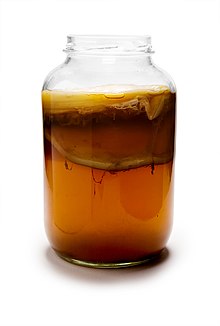**History and Spread**:
– Kombucha likely originated in the Bohai Sea district in China and spread to Russia and Europe.
– Consumption increased in the U.S. in the early 21st century.
– Variations of Kombucha exist in different cultures.
– Historical references date back to 220 BC.
– Popularized in the West in the late 20th century.
**Composition and Production**:
– Kombucha culture is a symbiotic culture of bacteria and yeast (SCOBY).
– Yeast species in kombucha culture include Zygosaccharomyces, Candida, and others.
– Bacterial component includes acetic acid bacteria like Komagataeibacter xylinus.
– Kombucha is made by adding the culture into a sugared tea broth.
– Fermentation process typically takes 7-14 days.
**Health Claims and Risks**:
– Kombucha is promoted for various health benefits, but clinical proof is lacking.
– No clinical evidence supports the wide-ranging health claims.
– Reports of adverse effects related to kombucha consumption are rare but may be underreported.
– Serious side effects and occasional deaths have been associated with drinking kombucha tea.
– Adverse effects may include severe hepatic and renal toxicity.
**Commercial Aspects and Popularity**:
– Bottled kombucha became available commercially in the late 1990s.
– US sales of bottled kombucha were $400 million in 2014.
– Market growth is driven by health-conscious consumers.
– Varieties with added flavors and adaptogens have emerged.
– Recognized as a potential alternative to alcoholic beverages.
**Other Uses and Applications**:
– Dried kombucha culture can be used to create a leather-like textile.
– SCOBY can be dried and eaten as a snack.
– Textiles can be dyed using plant-based dyes.
– Kombucha in fashion and textiles as a sustainable alternative.
– Culinary uses of kombucha include vinegar, smoothie additives, and salad dressings.
Kombucha (also tea mushroom, tea fungus, or Manchurian mushroom when referring to the culture; Latin name Medusomyces gisevii) is a fermented, lightly effervescent, sweetened black tea drink. Sometimes the beverage is called kombucha tea to distinguish it from the culture of bacteria and yeast. Juice, spices, fruit or other flavorings are often added.
 Kombucha tea, including the culture of bacteria and yeast, which is not usually consumed | |
| Type | Flavored cold tea drink with fermentation byproducts |
|---|---|
| Country of origin | China |
| Alcohol by volume | <0.5% (commercial) |
| Proof (US) | <1 (commercial) |
| Color | Cloudy, commonly pale or dark brown and sometimes green |
| Flavor | Fermented, effervescent |
| Ingredients | Tea, sugar, bacteria, yeast |
| Variants | Fruit juices or spices added |
| Related products | Water kefir, kefir, kvass, beer, iced tea |
Kombucha is thought to have originated in China, where the drink is traditional. By the early 20th century it spread to Russia, then other parts of Eastern Europe and Germany. Kombucha is now homebrewed globally, and also bottled and sold commercially. The global kombucha market was worth approximately US$1.7 billion as of 2019[update].
Kombucha is produced by symbiotic fermentation of sugared tea using a symbiotic culture of bacteria and yeast (SCOBY) commonly called a "mother" or "mushroom". The microbial populations in a SCOBY vary. The yeast component generally includes Saccharomyces cerevisiae, along with other species; the bacterial component almost always includes Gluconacetobacter xylinus to oxidize yeast-produced alcohols to acetic acid (and other acids). Although the SCOBY is commonly called "tea fungus" or "mushroom", it is actually "a symbiotic growth of acetic acid bacteria and osmophilic yeast species in a zoogleal mat [biofilm]". The living bacteria are said to be probiotic, one of the reasons for the popularity of the drink.
Numerous health benefits have been claimed to correlate with drinking kombucha; there is little evidence to support any of these claims. The beverage has caused rare serious adverse effects, possibly arising from contamination during home preparation. It is not recommended for therapeutic purposes.
Kombucha contains a small amount of caffeine.
